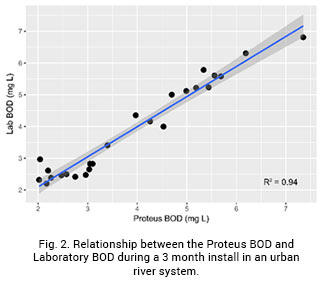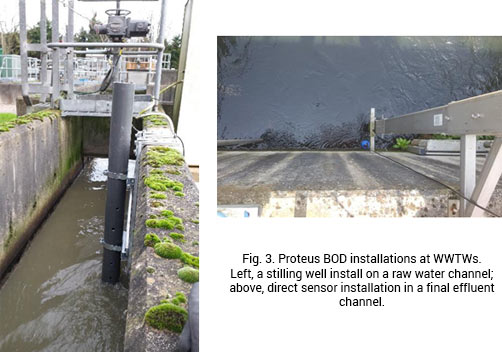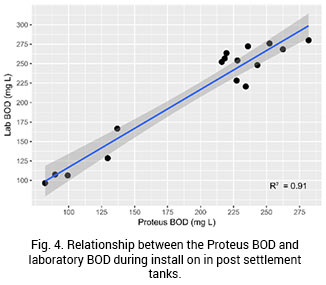Proteus BOD - a breakthrough in providing real-time, low-maintenance BOD
K.Khamis & R. Stevens
Proteus Instruments have launched what will be hailed as a global revolution in measuring Biochemical Oxygen Demand (BOD) with the new Proteus BOD. The state of the art monitoring platform incorporates the latest technology to provide accurate, reliable and maintenance free monitoring of BOD.
The Problem
 The organic load of waste water treatment works varies markedly in concentration and composition across both space and time; responding to the different treatment processes or stages (raw water – final effluent) and population demand. BOD, a laboratory bioassay dating back to 1917, is still the industry standard for measuring the quantity of reactive organic matter. BOD is currently used to assess the efficiency of waste water treatment works (WWTWs) is to ensure: (i) processes are optimised for cost and energy consumption, and; (ii) final effluents are below regulatory thresholds or levels that would cause environmental damage. Bourgeois et al. (2001) highlight the numerous issues with this test (see box 1 for summary of key points). The lag between sample collection and results is a major drawback which prohibits real-time alerts and control that could provide substantial cost savings to industry.
The organic load of waste water treatment works varies markedly in concentration and composition across both space and time; responding to the different treatment processes or stages (raw water – final effluent) and population demand. BOD, a laboratory bioassay dating back to 1917, is still the industry standard for measuring the quantity of reactive organic matter. BOD is currently used to assess the efficiency of waste water treatment works (WWTWs) is to ensure: (i) processes are optimised for cost and energy consumption, and; (ii) final effluents are below regulatory thresholds or levels that would cause environmental damage. Bourgeois et al. (2001) highlight the numerous issues with this test (see box 1 for summary of key points). The lag between sample collection and results is a major drawback which prohibits real-time alerts and control that could provide substantial cost savings to industry.
The Solution
Fluorescence spectroscopy is a selective and sensitive optical technique enabling in-situ, real-time measurement of dissolved organic matter. Molecules absorb light of a specific wavelength and orbiting electrons are excited to a higher energy state. The electrons then emit light of a specific wavelength to return to the base state. The use of fluorescence spectroscopy as a technique for the rapid assessment of organic matter quality and quantity in waste water was first proposed by Reynolds & Ahmad (1997) and has recently been highlighted as an effective tool for monitoring treatment processes and assessing efficiency (Bridgeman et al. 2013). Both these studies highlighted that tryptophan-like fluorescence (TLF), a fluorescence signal associated with amino-acids, proteins and phenols, was strongly related to BOD concentration across the treatment process.
The TLF peak is generally associated with excitation at ~280nm and emission at ~350nm see red box on excitation emission matrix (map of fluorescence optical space). However, analysis of TLF has until recently required sample collection and transport to a laboratory for analysis on expensive, large, power hungry spectrofluorometers.
Over the last 3 years RS Hydro have developed and rigorously testing the Proteus BOD; a fluorescence based real-time BOD monitoring platform. By combining a miniaturised LED based TLF sensor, thermistor and turbidity sensor the Proteus BOD is able to provide users with a highly accurate and reliable real-time indication BOD.

The Proteus BOD is unique as, it has a strong scientific under pinning with multiple research articles in international scientific journals (e.g. Khamis et al., 2015, 2017). In addition, the sensor is embedded with robust correction algorithms to account for signal interference associated with temperature and turbidity variability providing unrivalled accuracy and repeatability. The Proteus BOD also comes equipped with a standard factory BOD calibration derived from installations across a diverse range of applications, which can be tweaked for specific monitoring sites for optimal accuracy. RS Hydro provide consultation on all aspects of installation and calibration and strive to provide the optimal solution for all clients. Furthermore, the Proteus BOD also has an integrated wiper for cleaning all optical windows to eradicate fouling in demanding environments, thus reducing the need for user intervention and ensuring a stable baseline for long term deployments.

Applications
The Proteus BOD has been deployed for extended periods in urban river systems with wastewater drainage problems (i.e. CSOs and cross-connections). In these systems, the Proteus BOD is able to measure BOD very accurately during base flow and storm flow conditions (see Fig 2).
Extended installations of the sensor at various WWTWs have also yielded excellent results. One application involved the deployment of the sensor at 3 stages (raw inlet, settlement tank and final effluent) through a WWTW (~50,000 PE). Other installations have involved deployment on the final effluent lines of a large WWTW (>150,000 PE) with particularly strict discharge permits. Parallel grab samples were collected at all sites and analysed for BOD5 in accredited laboratories. Across the various installations (see Fig. 3) the sensor has provided accurate and reliable readings across a wide range of BOD concentrations (see Fig.4).
 In addition to the industrial applications a number of research organisations have purchased the sensor package and are using it to improve understanding of reactive organic matter dynamics. The Birmingham Institute of Forest Research (BIFOR) purchased two units for a long-term monitoring project and are extremely happy with the sensor stability and accuracy: Dr. Phillip Blaen BIFOR Research Fellow “The low maintenance requirements due to the integrated wiper and infrequent calibration requirements make the Proteus ideal for long term monitoring of organic matter”
In addition to the industrial applications a number of research organisations have purchased the sensor package and are using it to improve understanding of reactive organic matter dynamics. The Birmingham Institute of Forest Research (BIFOR) purchased two units for a long-term monitoring project and are extremely happy with the sensor stability and accuracy: Dr. Phillip Blaen BIFOR Research Fellow “The low maintenance requirements due to the integrated wiper and infrequent calibration requirements make the Proteus ideal for long term monitoring of organic matter”

Added benefits of the Proteus BOD
- Real-time data - easy link up to telemetry and SCADA for alarms/alerts of specified threshold exceedance (SDI 12, RS232, MODBUS)
- Easily deployable – wide range of environments (inc. inlets, effluents, reservoirs or boreholes)
- Versatile - modular design enables a wide range of additional parameters to be recorded concurrently (e.g. Temperature, turbidity, pH, conductivity, optical DO, chlorophyll a, ORP, ammonia)
- Portable - blue-tooth option available
- Sensitive- can detect very low concentrations for use in clean water systems
- Low maintenance - self-cleaning with automatic wiper and simple calibration only every 6 – 12 months
- Numerous applications
- Monitoring effluents for compliance
- Optimization of WWT processes (i.e. aeration – energy saving)
- Development of process control algorithms
- Identification of cross-connected sewers
- Combined sewage overflow monitoring
Summary
The new Proteus BOD (patent pending)is a versatile sensing unit that can provide real-time BOD data alongside traditional parameters (pH, conductivity etc.); thus, incorporating all your sensing needs into a single, easily deployable, low maintenance monitoring platform. The savings associated with the Proteus BOD are comprehensive and include: 1. reduced laboratory costs, 2. reduced likelihood of fines and reputational damage, 3. energy savings through process optimization and 4. Any additional cost savings associated with BOD sampling. The Proteus BOD is set to change the way reactive organic matter loads are monitoring- improving reliability, accuracy and resolution.
References
Bourgeois W, et al. 2001. On-line monitoring of wastewater quality: a review. J Chem Technol Biotechnol 76: 337–348.
Bridgeman J, et al. 2013. Determination of changes in wastewater quality through a treatment works using fluorescence spectroscopy. Environmental technology 34 : 3069–77.
Khamis K, et al. 2015. In situ tryptophan-like fluorometers: assessing turbidity and temperature effects for freshwater applications. Environmental science. Processes & impacts 17 : 740–52.
Khamis K, et al. 2017. Continuous field estimation of dissolved organic carbon concentration and biochemical oxygen demand using dual-wavelength fluorescence, turbidity and temperature. Hydrological Processes 31 : 540–555.
Reynolds DM, Ahmad SR. 1997. Rapid and direct determination of wastewater BOD values using a fluorescence technique. Water Research 31 : 2012–2018.


